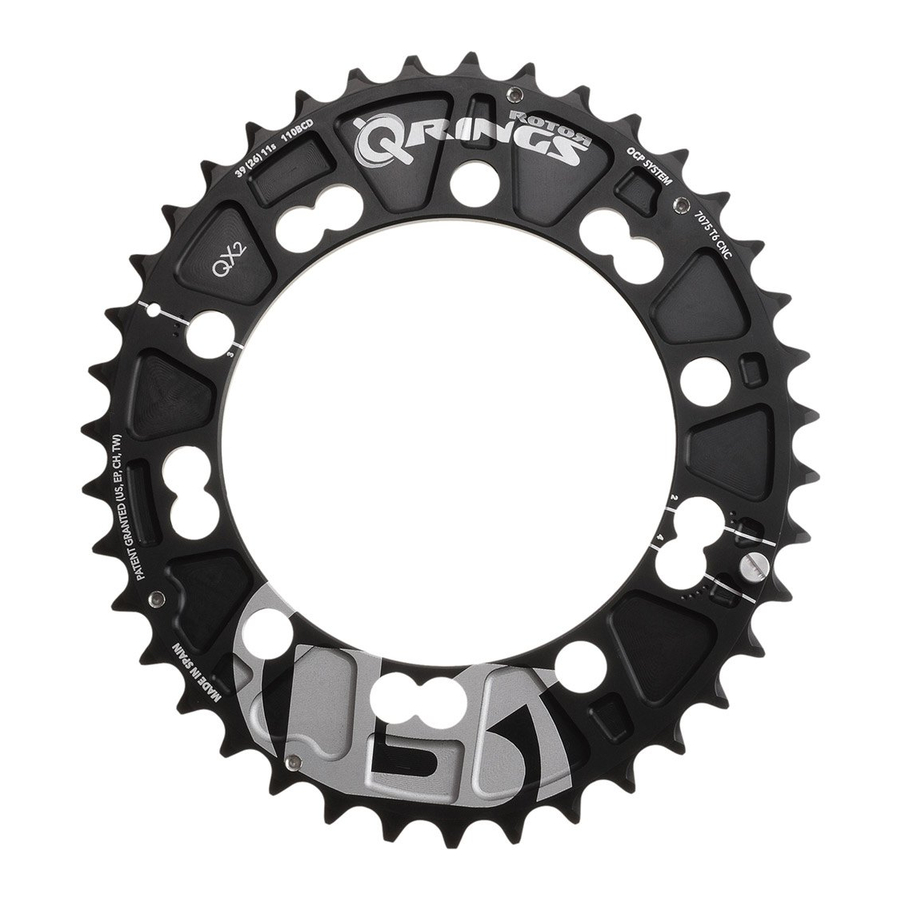
ROTOR Q-Ring - Bicycle Accessory Setup Guide
- Starter manual (2 pages) ,
- Setup manual (2 pages) ,
- Setup manual (8 pages)
Advertisement

ADAPTATION TO Q-RINGS
Road or XC2 bike? Start in position 3
Triathlon or TT bike? Start in position 4
XC3 bike? Start in position 2
Recumbent bike? See recumbent installation guide!
Q-Rings use your leg muscles at a different rate than round rings, thereby changing your intramuscular coordination of motor units. Following this guide will make your transition smooth. The duration of each stage varies from a day to a week.
Full adaptation takes a minimum of 10 hours, although benefits can be seen right away.
| Stage | Riding Sensations | What's Really Happening |
| Stage 1: Increase Pedal Efficiency | Pedaling may initially feel different, possibly leading to a faster or slower cadence than usual, but any jerkiness will gradually smooth out. | You're learning to pedal more efficiently. Muscle fibers are adaptating and muscle activation is improving. This usually happens rather quickly. |
| Stage 2: Better Muscle Balance | You are feeling more capable, more powerful, & you have a better spin when climibing. A new sensation may be felt in stronger or weaker leg muscles as adaptation occurs. Less knee pain for those that suffer from it. | Your leg muscles are starting to achieve a new, more efficient and balanced pedal stroke. |
| Stage 3: Full Activation | Your pedal stroke will start to feel smoother now, although it may not yet be pefect. (If you are experiencing joint pain see OCP setup guide below). | Improved biomechanic efficiency allows for full activation of muscle groups, thereby creating more power than with round chainrings. Knee problems are diminished with reduced knee loads. |
| Stage 4: Customization and Finalization | If you are in the right OCP position, pedaling will be as smooth or better than before and you will feel more capable. If you are in the wrong OCP position, you wont feel any advantage and may feel uncomfortable. See part 2 to resolve this issue. | Q-Rings reduce your weakness (creating less negative work in the "dead spot") and optimize performance (creating more postive work in the downstroke), enabling you to ride through tough conditions better than with round rings. |
CUSTOMIZING Q-RING SETUP
It is recommended you complete part 1 (minimum 10 hours riding) before changing your OCP (Optimum Chainring Position) setup
| Symptom | Cause | Solution |
| Acceleration and sprinting are easy but maintaining speed is difficult Pedaling resistance comes too late/hyperextended ankle You need a lower cadence to be comfortable Your sit further forward than usual to pedal comfortably It is comfortable to pedal standing but not when sitting Pain at the back of the leg behind the knee that you haven't had before | You are arriving at the max chainring diameter too late (OCP number too big) | Reduce OCP number by only 1* step: *1/2 step if you have a MAS spider |
| I'm not experiencing any problems; my Q-Rings are working fine. | You are already in an optimal position! | |
| Steady speeds are easy but accelerations and sprinting are difficult Pedaling resistance occurs too early/hyperflexed ankle You need to increase cadence to be comfortable You sit further back than usual to pedal comfortably It is comfortable to pedal seated but not when standing Pain at the front of the knee that you haven't had before | You are arriving at the max chainring diameter too soon (OCP number too small) | Increase OCP number by only 1* step: *1/2 step if you have a MAS spider |
Different bikes may need differen OCP positions. / Adjacent chainrings may need different positions / XC3 rings only have 3 positions / XC2 rings only have positions 2-4

Documents / ResourcesDownload manual
Here you can download full pdf version of manual, it may contain additional safety instructions, warranty information, FCC rules, etc.
Advertisement
 4
4














Need help?
Do you have a question about the Q-Ring and is the answer not in the manual?
Questions and answers